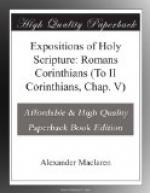Part of the ceremonial of the Passover was the presentation in the Temple of a barley sheaf, the first of the harvest, waved before the Lord in dedication to Him, and in sign of thankful confidence that all the fields would be reaped and their blessing gathered. There may be some allusion to that ceremony, which coincided in time with the Resurrection of our Lord, in the words here, which regard that one solitary Resurrection as the early ripe and early reaped sheaf, the pledge and the prophecy of the whole ingathering.
Now there seem to me, in these words, to ring out mainly two things—an expression of absolute certainty in the fact, and an expression of unbounded triumph in the certainty of the fact.
And if we look at these two things, I think we shall get the main thoughts that the Apostle would impress upon our minds.
I. The certainty of Christ’s Resurrection.
‘Now is Christ risen,’ says he, defying, as it were, doubt and negation, and basing himself upon the firm assurance which he possesses of that historical fact. ‘Ah!’ you say, ’seeing is believing; and he had evidence such as we can never have.’ Well! let us see. Is it possible for us, nineteen centuries nearly after that day, to catch some echo of this assured confidence, and in the face of modern doubts and disbeliefs, to reiterate with as unfaltering assurance as that with which they came from his glowing lips, the great words of my text? Can we, logically and reasonably, as men who are guided by evidence and not by feeling, stand up before the world, and take for ours the ancient confession: ’I believe in Jesus Christ, His only Son, our Lord, who suffered under Pontius Pilate, was crucified, dead, and buried. The third day He rose again from the dead’? I think we can.
The way to prove a fact is by the evidence of witnesses. You cannot argue that it would be very convenient, if such and such a thing should be true; that great moral effects would follow if we believed it was true, and so on. The way to do is to put people who have seen it into the witness-box, and to make sure that their evidence is worth accepting.
And at the beginning of my remarks I wish to protest, in a sentence, against confusing the issues about this question of the Resurrection of Jesus Christ in that fashion which is popular nowadays, when we are told that miracle is impossible, and therefore there has been no Resurrection, or that death is the end of human existence, and that therefore there has been no Resurrection. That is not the way to go about ascertaining the truth as to asserted facts. Let us hear the evidence. The men who brush aside the testimony of the New Testament writers, in obedience to a theory, either about the impossibility of the supernatural, or about the fatal and final issues of human death, are victims of prejudice, in the strictest meaning of the word; and are no more logical than the well-known and proverbial reasoner who, when told that facts were against him, with sublime confidence in his own infallibility, is reported to have said, ‘So much the worse for the facts.’ Let us deal with evidence, and not with theory, when we are talking about alleged facts of history.




